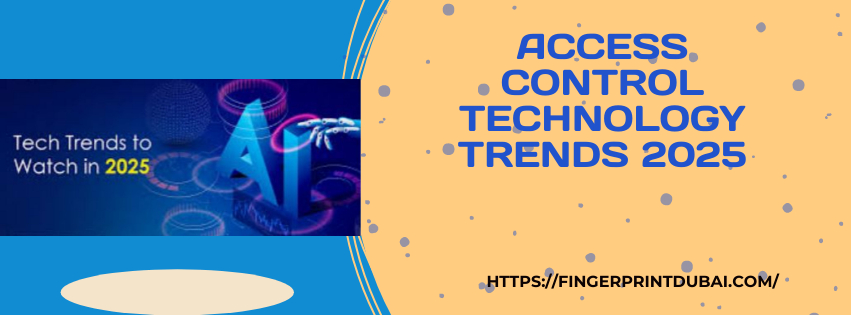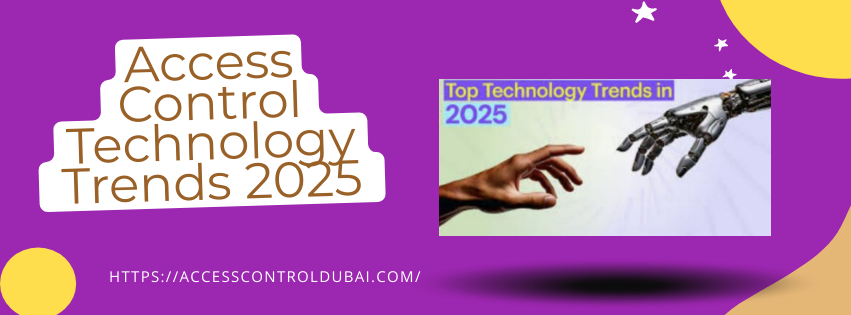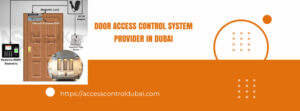Access Control Technology Trends 2025 are set to revolutionize the way we think about security and convenience in our daily lives. As we step into a new era of technological advancements, the landscape of access control is evolving rapidly, offering exciting possibilities for businesses and individuals alike. Let’s dive into the top trends that are shaping the future of access control in 2025.

Access control technology plays a crucial role in ensuring the safety and security of individuals and organizations by regulating who can access certain spaces or information. As technology continues to evolve at a rapid pace, it is important to stay abreast of the latest trends in access control technology to effectively protect assets and prevent unauthorized access. By the year 2025, several key trends are expected to shape the future of access control technology, including the rise of biometric authentication, the integration of artificial intelligence, and the increasing use of cloud-based solutions.
One of the most prominent trends in access control technology by 2025 is the widespread adoption of biometric authentication methods. Biometric technologies such as fingerprint scanning, facial recognition, and iris scanning are becoming increasingly popular as they offer a higher level of security than traditional methods like passwords or access cards. By using unique physical characteristics to verify an individual’s identity, biometric authentication can help prevent unauthorized access and reduce the risk of security breaches.
Another important trend in access control technology is the integration of artificial intelligence (AI) into access control systems. By leveraging AI algorithms, ABM access control systems can analyze and learn from patterns of behavior to detect anomalies and potential security threats. AI-powered access control systems can also automate processes and improve efficiency by reducing the need for manual oversight. As AI technology continues to advance, it is expected to play a more significant role in enhancing the security capabilities of access control systems.
In addition to biometric authentication and AI integration, the adoption of cloud-based access control solutions is expected to increase by 2025. Cloud-based access control systems offer several advantages over traditional on-premises solutions, including greater scalability, flexibility, and accessibility. With cloud-based systems, organizations can easily manage and monitor access control across multiple locations, devices, and users, while also benefiting from improved security and data protection measures.

One key benefit of cloud-based access control systems is the ability to remotely manage and monitor access control devices and user permissions from any location. This level of flexibility and convenience allows organizations to quickly respond to security threats or access requests, without the need for physical presence on-site. Cloud-based access control solutions also offer seamless integration with other security systems and IoT devices, enabling a more holistic approach to security management.
By 2025, it is anticipated that access control technology will continue to evolve to meet the growing demands of an increasingly interconnected and digitized world. As the Internet of Things (IoT) expands, access control systems will likely integrate with a wide range of IoT devices, enabling more streamlined and efficient security management. By leveraging IoT technology, access control systems can gather and analyze data from various sensors and devices to enhance security protocols and improve overall safety measures.
Another emerging trend in access control technology is the increasing use of mobile access solutions. With the popularity of smartphones and wearable devices, many organizations are opting for mobile-based access control systems that allow users to gain entry through their mobile devices. By using mobile access solutions, organizations can simplify the access process for users, improve convenience, and enhance security by enabling biometric authentication through mobile devices.
Furthermore, by 2025, access control technology is expected to become more interconnected with other security systems, such as video surveillance, intrusion detection, and identity management solutions. By integrating access control with these complementary technologies, organizations can create a comprehensive security ecosystem that provides a more robust defense against security threats and unauthorized access. This level of integration also enables organizations to automate security processes and respond quickly to emerging threats.

As access control technology evolves and becomes more sophisticated, it is essential for organizations to prioritize cybersecurity measures to protect their systems from potential cyber threats and vulnerabilities. By implementing robust security protocols, encryption techniques, and regular security audits, organizations can safeguard their access control systems and prevent unauthorized access or data breaches. Additionally, ongoing training and awareness programs for employees can help mitigate the risks associated with social engineering attacks and human error.
the future of access control technology in 2025 promises to be filled with innovative solutions that enhance security, convenience, and efficiency for individuals and organizations. By embracing trends such as biometric authentication, AI integration, cloud-based solutions, and mobile access, organizations can stay ahead of the curve and ensure the safety of their assets and information. As technology continues to advance, it is important for organizations to adapt and evolve their access control systems to meet the evolving security challenges of the digital age. By staying informed and proactive in implementing the latest access control technologies, organizations can create a secure and resilient security infrastructure
1. Cloud-Based Systems: The New Norm
Cloud-based access control systems are taking center stage in 2025, offering unparalleled flexibility and scalability. These systems allow for centralized management, making it easier than ever to control multiple sites from a single platform. Imagine being able to grant or revoke access to your office building from the comfort of your home, or instantly updating security protocols across all your company’s locations with just a few clicks.
Cloud-based solutions are not just convenient; they’re also cost-effective, reducing the need for extensive on-site hardware and simplifying disaster recovery processes.
2. Mobile Credentials: Your Smartphone is Your Key
Last decay commonly we fumbling for keys or access cards. In 2025, your smartphone is all you need to gain entry. Mobile credentials, utilizing technologies like QR codes and Bluetooth Low Energy (BLE), are becoming the go-to method for secure and convenient access. Picture this: you approach your office building, and with a simple tap on your phone, the doors swing open, recognizing you instantly. This trend not only enhances user experience but also significantly reduces the risk of lost or stolen physical credentials.
3. Biometric Authentication: Beyond Fingerprints
Biometric access control is reaching new heights in 2025, moving far beyond simple fingerprint scans. Advanced systems now incorporate facial recognition, iris scanning, and even vein pattern recognition for unparalleled security. Imagine walking into a high-security area where a quick glance at a camera is all it takes to verify your identity and grant access. These cutting-edge biometric solutions offer a perfect blend of security and convenience, making unauthorized access nearly impossible.
4. AI and Machine Learning: Smart Security Gets Smarter
Artificial Intelligence (AI) and Machine Learning (ML) are revolutionizing access control systems in 2025. These technologies enable predictive analytics, anomaly detection, and behavior-based authentication, taking security to a whole new level. Picture a system that can predict potential security breaches before they happen, or automatically adjust access privileges based on unusual patterns of behavior. AI-powered access control doesn’t just react to threats; it anticipates and prevents them, offering a proactive approach to security.
5. Integration with IoT Devices: A Connected Security Ecosystem
In 2025, access control systems are no longer standalone entities but part of a larger, interconnected security ecosystem. Integration with IoT devices like CCTV cameras, alarm systems, and even HVAC controls creates a comprehensive security network. Imagine a scenario where an unauthorized access attempt triggers not just an alarm, but also locks down sensitive areas, alerts security personnel, and provides real-time video feeds – all automatically and instantaneously. This level of integration ensures a more robust and responsive security infrastructure.
6. Touchless Entry: The New Standard
In the wake of global health concerns, touchless entry systems have become a critical trend in access control technology for 2025. These systems allow users to enter secured areas without physical contact, using gestures, proximity sensors, or mobile credentials. Picture entering your workplace without touching a single surface – doors open automatically as you approach, elevators respond to voice commands, and your workspace adjusts to your preferences, all hands-free. Touchless entry not only enhances hygiene but also improves the overall user experience.
7. Unified Security Systems: Breaking Down Silos
The trend towards unified security systems is gaining momentum in 2025. This approach integrates access control with video surveillance, visitor management, and building management systems for a holistic security solution. Imagine a single dashboard where you can monitor access logs, view live camera feeds, manage visitor credentials, and control building systems – all in one place. This integration not only improves security but also enhances operational efficiency and provides valuable insights for business decision-making.

Access Control Technology Trends 2025: What You Need to Know
Access Control Technology Trends 2025 are rapidly evolving, transforming how we secure our physical and digital spaces. From traditional keycards to cutting-edge biometric solutions, the landscape is constantly shifting. Let’s dive into some of the most significant trends shaping the future of access control.
1. The Rise of AI-Powered Access Control
Artificial intelligence (AI) is revolutionizing access control by adding an extra layer of intelligence and automation. AI algorithms can analyze data from various sources, such as video surveillance, intrusion detection systems, and even social media, to identify and mitigate potential threats. For example, AI-powered systems can detect anomalies in behavior, such as unusual entry times or loitering, and alert security personnel in real-time. This proactive approach enhances security and reduces the risk of unauthorized access.
2. The Integration of Biometrics
Biometric authentication, such as fingerprint recognition, facial recognition, and iris scanning, is becoming increasingly prevalent in access control systems.

These technologies offer unparalleled security and convenience, as they are unique to each individual. For example, facial recognition systems can quickly and accurately identify authorized personnel, even in crowded areas. The integration of biometrics with other access control technologies, such as mobile credentials and cloud-based platforms, is creating more robust and user-friendly solutions.
3. The Growing Importance of Mobile Access
Mobile devices are becoming the primary means of access control for many organizations. Employees can use their smartphones to unlock doors, access secure areas, and manage their access credentials. Mobile access solutions are convenient, cost-effective, and easy to deploy and manage. They also offer enhanced flexibility and scalability, as access permissions can be easily updated and revoked remotely.
4. The Cloud-Based Revolution
ABM Innovative FZE cloud-based access control systems in Dubai market are gaining popularity due to their wide scope of scalability, vital flexibility, and low cost-effectiveness. These systems allow organizations to manage their access control infrastructure from anywhere with an internet connection. Cloud-based platforms also offer enhanced data security and disaster recovery capabilities. By leveraging the power of the cloud, organizations can streamline their access control operations and improve their overall security posture.
5. The Focus on User Experience
User experience (UX) is becoming increasingly important in access control. Systems that are easy to use and understand are more likely to be adopted and used effectively. Intuitive interfaces, seamless integration with other systems, and personalized settings are all key factors in creating a positive user experience. By prioritizing UX, organizations can improve employee satisfaction and enhance the overall security of their facilities.
6. The Importance of Cybersecurity
As access control systems become increasingly interconnected, cybersecurity is more critical than ever. Organizations must take steps to protect their systems from cyber threats, such as hacking and data breaches. This includes implementing strong authentication measures, regularly updating software, and conducting security audits. By prioritizing cybersecurity, organizations can ensure the integrity and confidentiality of their access control data.

FAQs:
What are the benefits of AI-powered access control?
AI-powered access control systems can enhance security by detecting anomalies in behavior, such as unusual entry times or loitering. They can also automate tasks, such as granting and revoking access permissions.
How can I improve the user experience of my access control system?
Prioritize ease of use by implementing intuitive interfaces, providing clear instructions, and offering personalized settings.
What are the cybersecurity risks associated with access control systems?
Cyber threats such as hacking and data breaches can compromise the security of access control systems.
Organizations must take steps to protect their systems by implementing strong authentication measures, regularly updating software, and conducting security audits.
What is the future of access control technology?
The future of access control technology is likely to involve a continued convergence of AI, biometrics, mobile devices, and cloud computing.
We can expect to see even more sophisticated and integrated solutions that offer enhanced security, convenience, and flexibility.
By staying abreast of the latest Access Control Technology Trends 2025, organizations can enhance their security posture, improve operational efficiency, and create a more secure and welcoming environment for their employees and visitors.
I hope this comprehensive article provides you with valuable insights into the evolving world of access control.
Please let me know if you have any further questions or would like me to expand on any of these points.
In conclusion,
Access Control Technology Trends 2025 are all about smarter, more integrated, and user-friendly systems. From cloud-based management to AI-powered analytics, these trends are shaping a future where security is not just robust but also seamlessly woven into our daily lives. As we embrace these innovations, we’re stepping into an era where access control is no longer just about keeping threats out, but about creating intelligent, responsive environments that enhance both security and convenience.




